Original URL: https://www.theregister.com/2013/11/15/doctor_who_build_your_own_sonic_screwdriver/
Build your own WORKING Sonic Screwdriver... for a UNDER A FIVER
Our man embarks on the ULTIMATE maker project for fans
Posted in Science, 15th November 2013 16:05 GMT
Doctor Who @ 50 The Doctor’s sonic screwdriver has become steadily more iconic as the years progressed. Despite disappearing in the middle of the Time Lord’s career, it’s now firmly – not to say commercially – integrated into the Doctor Who canon. So there’s no more to say on the subject, right?
Wrong.
Earlier this year, the Sonic Screwdriver came up during an editorial meeting at Vulture Towers. The discussion quickly turned into a debate about whether the screwdriver was a clever aspect of the character or merely a deus ex machina for writers who didn’t want to be distracted by plot mechanics when they could be penning soul-searching soliloquies or homoerotic banter.
We also wondered how you could possible make one of your own. We can’t look into the minds of modern Who writers, but we can have a go at making a sonic screwdriver for ourselves. Here’s how it worked out.
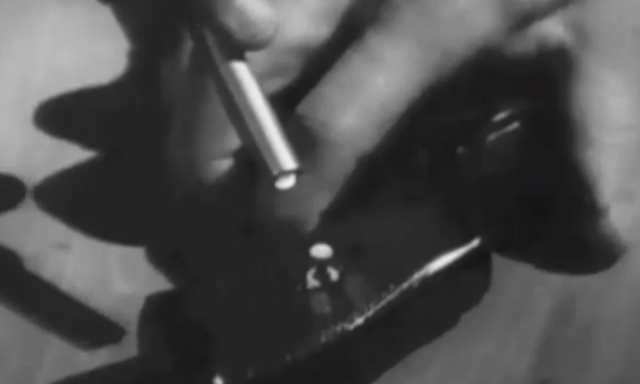
No human would turn a screw like that
Source: BBC
The real Sonic Screwdriver didn’t even turn up until the second Doctor, who generally used it to prove how alien he was. Unlike a regular screwdriver which removes screws by physically rotating them, the “sonic” screwdriver removes them without physical contact - clearly a huge advance and, more importantly to the plot, incontestable proof that the character so notably played by Patrick Troughton, wasn’t a human.
There are, according to official sources, nine different models of Sonic Screwdriver, and a handful of similar devices (mainly) wielded by characters from well-equipped futures.
Fan Will Marler has created a particularly beautiful rendition of the whole range. But the casual fan will probably only recognise four distinct models, with perhaps the most well-known being the stick-with-a-red-circle-on-top as used by John Pertwee. Pertwee, of course, lacked gadgets having been stranded on Earth for budgetary reasons. Tom Baker got to use it too and so, briefly, did Peter Davison.
Making something to rotate things from a distance, even screws, is probably beyond the El Reg budget but straying comfortably into DARPA territory. The third Doctor’s reference to his electronic “door handle”, used in the 1970 story Inferno helps little, though it does point us towards a possible get-out clause for our project.
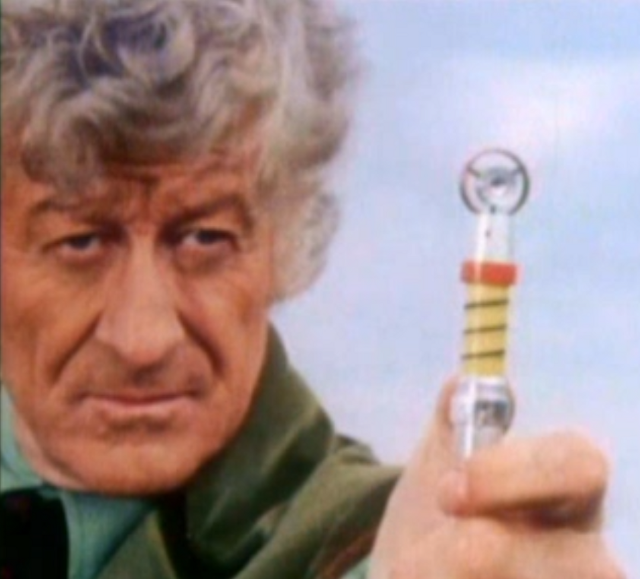
Pretty colours were all the rage in the 1970s
Source: BBC
The Sonic Screwdriver isn’t just used to disable Daleks and summon the Tardis when the plot demands, it also provides comic relief by lighting candles and opening the occasional bottle of champagne, and works as a display showing information which would be too complicated to relate on the television screen - sharing that facility with Star Trek’s Tricorder. So we don’t need to create something dramatic to replicate its function, if not its form.
A blow-torch was tempting, and would replicate some of the capabilities demonstrated by the increasingly versatile original. A pocket blow-torch can light candles, melt plastic and cut rope and (at a push) metal, but making one from scratch is tough. In any case, existing devices bear an uncanny similarity to a steampunk Sonic Screwdriver already.
But it’s “detecting mysterious forces” where the Doctor’s screwdriver really comes to the aid of the lazy writer. Eddies in the space-time continuum, psychic energy or traces of mutated DNA might be beyond our grasp but there is the marvelously simple “Ridiculously Sensitive Electric Charge Detector”, a circuit which requires only three components – two of which don’t need to be accurately specified. This is our kind of electronics project.

This is my kind of circuit
The design calls for a 9V battery, but happily runs off 3V. This was important: shoehorning a box-type battery into the shape of a Sonic Screwdriver would challenge even the designers of the Tardis. The light goes out when static electricity is nearby, such as a recently used comb or plastic rod. As it stands the range is only a few centimetres, but extend the antenna and the sensitivity increases. The designer reckons a 50cm antenna will spot someone brushing their hair 5m away - an ability worthy of any Time Lord, surely?
That circuit will detect mysterious forces - and if you don’t consider electromagnetism to be mysterious then you’re either way too cynical or Stephen Hawking - but it was almost too simple, so I decided to add a touch control. Now my Sonic Screwdriver would be controlled with a gentle caress rather than a sliding switch or button. After the minimum of searching, HobbyTronics turned up an IC which would meet our requirements for a couple of quid. Given my soldering skills, I ordered three and slapped one onto the breadboard.

The Touch IC is suprisingly robust too, coping with repeatedly-wrong connections
The touch circuit also runs happily on 3V, which was a relief. Connected to a bench supply it triggers too easily (when a wire is connected) but once hooked up tp a couple of AA batteries it works perfectly. So much so that I decided to keep the red LED used for testing as a confidence light (so the user knows when the screwdriver is on) and as a diagnostic (so I know when our wiring has failed).
Now we have a circuit which responds to a touch and detects mysterious forces, but it doesn’t yet look the part.
The evolution of a prop
At the end of the ring-on-stick phase, the Doctor’s screwdriver got zapped by the best special effects the BBC could afford [surely "Terileptil laser fire"? - Ed]. By this point the Sonic Screwdriver was becoming a fix-all, too powerful to be allowed to exist. Robot dog K9 had forged a similar path, but while K9 got two spin-off series – K9 and Company and a cartoon, or three if you include his regular appearance in The Sarah Jane Adventures – the Sonic Screwdriver, like so many screwdrivers before it, got left in a drawer.
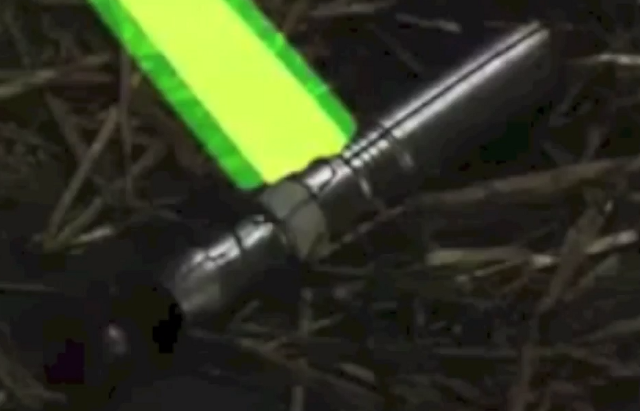
It would be nice to say the effect looked better in motion, but it would be a lie
Source: BBC
But it was too iconic to leave out of the 2005 reboot, during which it became stubbier, with a blue light. These days, it’s altogether longer and sports a glowing green tip. And claws.
Since the Doctor’s return, writers have struggled to avoid using the Sonic Screwdriver. Rebooter Russell T Davies reportedly said it should never be used to tie up a story but that may be a recognition of his own weakness to its charms. He certainly felt that it was the ideal mechanism to get the Doctor out of petty inconveniences which might otherwise hold up the plot while the Time Lord overcomes them.
These days the Sonic Screwdriver can dry clothes (the continuity person’s dream), boost mobile data rates across time and space, and even enable international and, indeed, interspatial roaming. It dosen’t work on wood (except when it does) and it can only locks (except when they’re mechanical, sometimes), and (perhaps most importantly of all) it can make a huge amount of licensing money for the BBC.
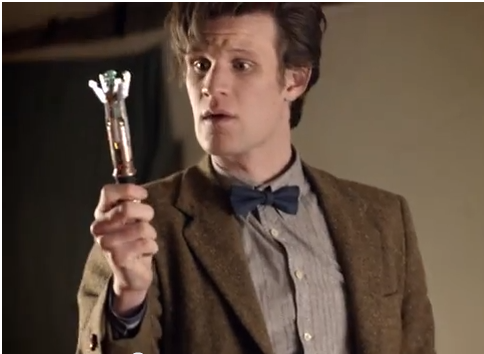
I detect... a massive marketing opportunity
Source: BBC
These days you can buy a Sonic Screwdriver to do just about anything. Collectors are seduced by incredibly accurate renditions of the actual props, while gadget fans can get a universal remote or a Wii controller in roughly the right shape - the latter actually being cheaper than the Nintendo version. You can even buy a model of the Sonic Screwdriver with a real screwdriver built in - what will they think of next?
Fans have thought of a good many things, particular credit going to the chap who created a Sonic Screwdriver which will unlock his car, but the internet is awash with meticulously engineered replicas and functional models created by hobbyists armed with CNC machines, artistic skill and a good deal of time.
Sadly, I have none of those, but I do have a totted* woodwork lathe and some Perspex tube so they will have to do. The Perspex tube was an obvious choice. Sprayed on the inside using can of car touch-up paint it becomes semi-transparent so you can see the circuits and chips inside. Capping it was more difficult. My first plan was to make something out of Polymorph, the material with which anyone possessing a modicum of artistic talent can make just about anything. But without that talent, I just had lumps of off-white snot.
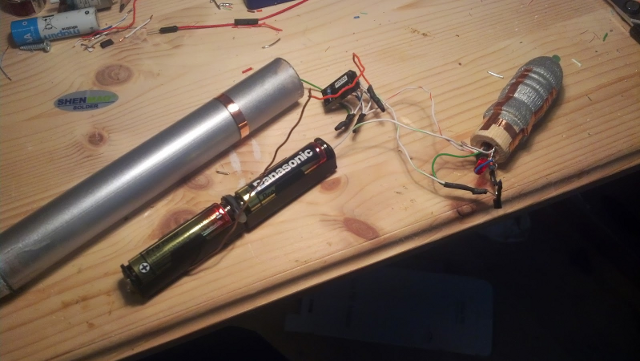
Some assembly required
So to the wood lathe. Turning wood is an acquired skill, and while I didn’t have time to acquire it, I did manage to turn out some end points and throw on some matte silver paint to cover my shoddy workmanship.
The sticky-backed copper is largely decorative, but the upper band is connected to the touch chip – though a hole drilled in the Perspex, with a ceramic bit – and one of the copper lines at the top connects to the antenna of the detector. Then it was just a matter of pushing everything together and hoping for the best.
Sadly the best didn’t arrive as the tube was too short to accommodate the electronics no matter how much they were squeezed, and a replacement tube had to be constructed before everything would fit together. But I got there in the end.
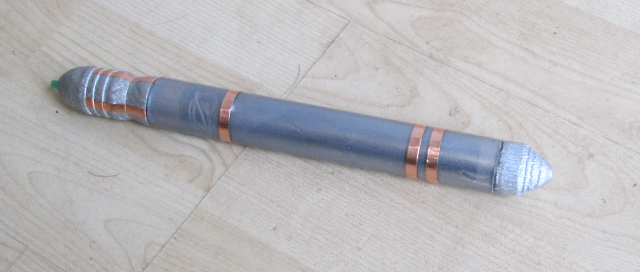
The lights aren't on here, obviously, but to be honest you'd be hard pressed to see them if they were
Somewhat to the surprise of everyone I showed it too, the constructed Sonic Screwdriver works as advertised, the body lights up red when the upper band is touched, and the greed LED can indeed detect the unseen forces of static electricity.
Sadly, neither LED is as bright as I might like. The green in particular works best in a well-darkened room, which is why there aren’t any photographs here of it in action. You’ll have to take it from me that it detects mysterious forces and displays the results in a form too complicated to be worth displaying on a TV screen. Surely all that's required of a real Sonic Screwdriver? ®
*"Totting", the art of grabbing discarded stuff from rubbish dumps and tips, for reuse or recycling. One who "tots" is a "totter", as in 76 Totter’s Lane, the location of the scrapyard in which we first encounter the Doctor.